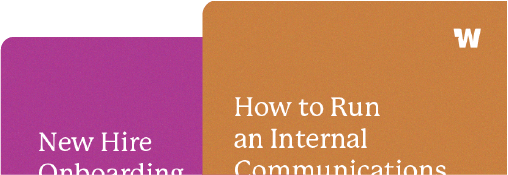How to get a bigger budget for employee experience & communications

When calculating a marketing budget as a percentage of revenue, the typical rule you hear is to invest about 10%. By contrast, HR and communications budgets often pale in comparison, typically coming in at about 1% of the entire marketing budget.
That’s not enough. In fact, we’re here to say that you should be advocating for at least 10% of the marketing budget (or 1% of the overall budget as a percentage of revenue).
Here’s how you can create the business case, set the baseline for the budget, and get stakeholder buy-in to ultimately receive the dollars you need to support your team’s employee experience and communication goals this year.
Creating the business case
If, for some reason, you’re still not totally convinced that your department deserves every dollar it can get next year, we’d like to present a few very compelling arguments. 🙂
(Note that the first part of this article borrows heavily from Gregg Apirian’s 2017 Forbes article, “Making Your Business A Great Place To Work Requires More Investment Than You Think.”)
Here’s where we’re starting from:
- In 2017, most HR and comms professionals estimate their employee experience budget at $10,000 or less per year.
- The average internal communications budget of an organization with more than 500 employees was reported at $185,000 per year.
- Contrast that with the fact that companies set aside million-dollar budgets for marketing and sales.
Of course, we know those numbers simply won’t work going forward. We know employees feel unengaged, disconnected, overwhelmed, and under-appreciated. We know they want flexibility, purpose, wellness benefits, recognition, and opportunity for growth. And we know that you know that the employee experience and communications should be your company’s number one priority for the upcoming year.
You simply can’t re-engage that workforce with the same paltry budget that your company had in 2021. You can’t put up printed posters in the break room and expect organizational alignment to follow. You can’t build an enviable employee experience on the back of a once-in-a-blue-moon catered lunch. You can’t send out beautiful, segmented email campaigns to customers and boring, plain text, all-staff emails to employees.

So, let’s be honest: the budgets given to HR and communications teams have completely failed to keep up with both executive and employee expectations.
Of course, wages and benefits are often the largest line item expense, but those are hardly the baseline for an impactful employee experience; they’re simply table stakes, and you aren’t going to make any impact on talent acquisition and retention if that’s all you have to work with. And even though many companies have started to shift focus into meaningfully improving the employee experience, there’s a difference between talking the talk and walking the walk. It’s impossible for an individual or a team to deliver on the level of experience that executives expect and employees want without the budget to back it.
You don’t need to have an equal budget for both your employee and customer experience program, but we do need company leadership to see the ROI is clear, the opportunity is there, and the increased investment is necessary.
The great news is that the ROI is incredibly clear and has been proven in report after report. There is countless research supporting the connection between an investment in employee engagement and the overall growth and success of the business. A few of the most-cited statistics include:
- Talent Culture found that increasing employee engagement investments by 10% can increase profits by $2,400 per employee per year. (You can calculate your budget request based on that alone!)
- Companies that invest in employee engagement consistently outperform those that don’t by 202%, according to a Dale Carnegie report.
- Companies with a high level of engagement report 22% higher productivity, according to Gallup data.
And it goes on and on and on. (Keep reading to see how to tailor your budget proposal to the facts and figures that your CEO and finance team will respond best to.)
What should I include in the budget?
It’s important that your budget proposal encompasses all of the resources you might need, including the program costs itself, any necessary hires, and the toolset.
After all, marketing departments don’t just have a budget; they also have a tech stack packed with powerful software and strategies to measure every customer engagement across both digital and physical channels, including the website, social media, text messaging, print, and more. They then compile and use all of that data and insights to form strategies for improvement all along the customer journey.
Companies should be budgeting for and using similarly powerful tools and techniques to measure and engage their employees. They should also be embracing a multichannel approach to employee engagement or risk increased attrition, misalignment, and/or poor performance.
As Gregg said:
“If you use email to engage customers and measure open rates, why not use it to communicate with your employees and evaluate their open rates, too? If you give your customers best-in-class e-commerce sites and mobile apps, then your employees should have the very best intranet or digital tools available. If the purpose of a brand is to build an enduring relationship with customers, then you need an employer brand to build an enduring relationship with employees, so they can support the customer brand. It’s a symbiotic relationship.”
That’s why, as a baseline, you should advocate for at least 10% of the marketing budget (or 1% of the overall budget as a percentage of revenue). And if you need to demonstrate a more convincing argument than all of the above, we’ve got you covered.

How do I propose the budget?
When proposing a larger budget (here’s a template to get you started!), you are likely going to be met with two main questions from your CEO/finance team:
- What did you do with the budget you had before?
- What are your objectives with the larger budget?
In terms of your previous budget, provide as many details as you can on how you used it effectively in the past: what business goals did it help support? What was the ROI (this can be qualitative or quantitative)? Were you over budget or under budget in the past? What are some past success stories you can share to help illustrate the value of this spend? What impact has that spend had on the company? Do a bit of due diligence on this one; it may be worth even putting together a short presentation to answer both questions.
For question two, you need to align the objectives of your employee engagement initiatives with business goals. We find the most success when you come at this with both a qualitative and quantitative approach; you want to speak to both the stakeholders’ emotions and their pragmatism.
For example: let’s say your leadership team believes their employee engagement problem doesn’t necessarily need a budget to be successful. They know they have a problem with engagement, but they just don’t see why the HR team can’t just figure out how to fix it for free.
You can overlay your employee engagement data with attrition data, and relatively quickly, you can have a numbers-backed case for a solid budget.
For example, let’s say that of the employees that rank as “completely disengaged,” half of them are leaving within the following year. Calculate the total cost of that attrition on the business. Most companies estimate that it costs about $30,000 to replace an employee (or up to 50% of a person’s salary), what with recruiting costs, output loss…even things like lost clients or historical knowledge.
Here’s how that plays out for a company of 500 employees, with 10% of them completely disengaged: 50 employees X $30,000 in replacement costs = $1,500,000.
Again, you can verify this with your own engagement data, but for argument’s sake, let’s assume that even just doing enough to get them out of the “disengaged” category halves the attrition rate — that’s already worth $750,000. (The budget request doesn’t have to be that number, but it can be your bargaining chip for asking for $250,000 or more.)
If you don’t have this specific engagement data, there are still quite a few approaches you can take.
One is to put together a data-based argument with any and all of the data that you do have. (Or perhaps your argument for a budget is to get the data you need to achieve these results for the company after all!)
Metrics to consider are things like:
- Attendance for all-hands meetings
- Open rates for employee emails
- Traffic to the company intranet
- Referrals from existing employees
- Glassdoor reviews
Even just selecting statistics that match what your CEO cares about may help you get this request over the line. AccessPerks has an absolutely unbelievable, seemingly never-ending list of employee engagement statistics to choose from to help you build your business case.
Dig through the information and choose facts and figures that relate to your company’s future goals; this will show that you are aware of what aspects of business are important to those key stakeholders, and demonstrates that you have put a lot of thought and research into your pitch.
Here’s a quick checklist to ensure you’re ready to make the request:
- Where are you spending the money?
- How are you spending the money?
- What are the issues it will solve, or help to solve?
- What will we save as the result of this spend? (Could be time, money, etc.)
- What’s the goal and how are you going to measure it?
- What will the ROI be?
- “What’s in it for me?”
If you can cover all of these things cohesively in your budget proposal, your request will have a much greater chance of being approved.

What do I do if the budget doesn’t get approved?
Even with an airtight, perfectly aligned budget proposal, there’s a chance that your request gets denied. But don’t worry, yet! You still have a couple of options.
1.) Get the budget from the marketing team
A more unconventional approach, and one that has personally worked on me in the past, is to buddy up to the marketing team and ask for 10% of their budget to be spent on internal marketing. (They’re likely thinking about this anyway, but just haven’t had a chance to actually formalize it.)
The trendlines to support this move are all there…employee advocacy on social media, internal and external brand consistency, event marketing, recruiting campaigns, public relations…it all may not drive direct revenue, but it has become a very significant part of a marketing team’s workload, whether they meant for it or not.
Plus, having a formal budget (and even a formal person) to manage this work is the right way to go, rather than having money or time “pulled from” the marketing budget…like employee t-shirt orders, open house/community events, booth materials for job fairs, Facebook recruiting ads, etc.
2.) Audit your existing employee engagement spend and re-allocate it
If your new budget didn’t get approved, you can still gather up a lot of spending power simply by auditing what’s already being spent in the “category” of employee engagement. You’d be surprised by what might be allocated to things like birthdays, wellness programs, training programs, work anniversaries, internal events, team outings, gift cards, and more.
Because of this, it’s very possible that many companies are already spending more money on recognition than they realize…but that spend isn’t aligned to the company’s overall goals, and it isn’t actually increasing engagement. By offering to bring those costs under the umbrella of a cohesive employee experience strategy, tracking the budget, and establishing clear objectives, you’ll find yourself in charge of a rather sizable set of funds that you can then reallocate to your more strategically designed programs and team needs.
Still need help making the case?








